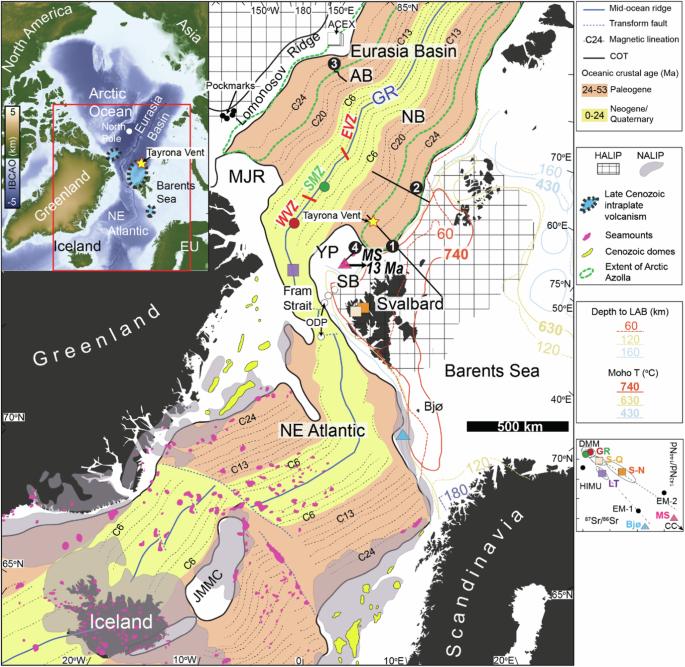Late Cenozoic intraplate volcanism as a trigger for hydrothermal venting in the Arctic southwestern Eurasia Basin
IF 8.1
1区 地球科学
Q1 ENVIRONMENTAL SCIENCES
引用次数: 0
Abstract
Intraplate volcanism has occurred for the last 35 million years within Northeast Atlantic and Arctic margins, including the western Barents Sea, Svalbard, and northern Greenland. Earlier studies have suggested that some of this volcanism might be sourced from nearby mid-ocean ridges. However, legacy data does not reveal correlations between the sporadic volcanism, despite comparable setting, ages, and compositions of basalts across the area. Here, we utilize a compilation of geophysical data to document late Cenozoic intraplate volcanism affecting the northeastern Yermak Plateau and southwestern Eurasia Basin located north of Svalbard. The identified seabed and subsurface features include volcanic (Mound-A) and hydrothermal vent systems (Tayrona Vent) formed approximately 10 and 2.6 million years ago, respectively. These intraplate volcanic products are coincident in age and origin with observed hydrothermal systems on Svalbard and Northeast Atlantic. We propose that these magmatic features are the result of intraplate volcanism associated with seismic and thermal anomalies in the mantle beneath northern Svalbard. Interpretation of seismic reflection profiles in the southwestern Eurasia Basin and north of Svalbard support a regional mantle thermal anomaly as the source of intraplate Cenozoic magmatism and associated hydrothermal features in the Arctic

晚新生代板内火山活动是欧亚大陆盆地西南部北极地区热液喷发的触发因素
在过去的 3500 万年中,板内火山活动一直发生在东北大西洋和北极边缘地区,包括巴伦支海西部、斯瓦尔巴特群岛和格陵兰岛北部。早期的研究表明,其中一些火山活动可能来自附近的大洋中脊。然而,尽管整个地区的环境、年龄和玄武岩成分具有可比性,但遗留数据并未揭示零星火山活动之间的相关性。在此,我们利用地球物理数据汇编,记录了影响斯瓦尔巴群岛以北叶尔马克高原东北部和欧亚盆地西南部的晚新生代板内火山活动。已确定的海底和次表层地貌包括火山(Mound-A)和热液喷口系统(Tayrona Vent),分别形成于大约 1000 万年前和 260 万年前。这些板块内的火山产物与斯瓦尔巴群岛和东北大西洋观测到的热液系统在年代和起源上相吻合。我们认为,这些岩浆特征是与斯瓦尔巴群岛北部地幔的地震和热异常有关的板内火山活动的结果。对欧亚盆地西南部和斯瓦尔巴群岛北部地震反射剖面的解释支持将区域地幔热异常作为板内新生代岩浆活动和北极地区相关热液特征的来源
本文章由计算机程序翻译,如有差异,请以英文原文为准。
求助全文
约1分钟内获得全文
求助全文
来源期刊

Communications Earth & Environment
Earth and Planetary Sciences-General Earth and Planetary Sciences
CiteScore
8.60
自引率
2.50%
发文量
269
审稿时长
26 weeks
期刊介绍:
Communications Earth & Environment is an open access journal from Nature Portfolio publishing high-quality research, reviews and commentary in all areas of the Earth, environmental and planetary sciences. Research papers published by the journal represent significant advances that bring new insight to a specialized area in Earth science, planetary science or environmental science.
Communications Earth & Environment has a 2-year impact factor of 7.9 (2022 Journal Citation Reports®). Articles published in the journal in 2022 were downloaded 1,412,858 times. Median time from submission to the first editorial decision is 8 days.
 求助内容:
求助内容: 应助结果提醒方式:
应助结果提醒方式:


